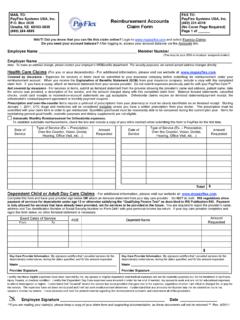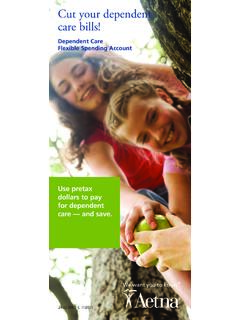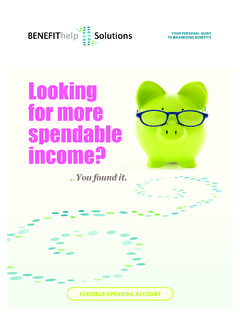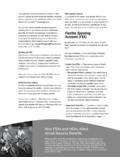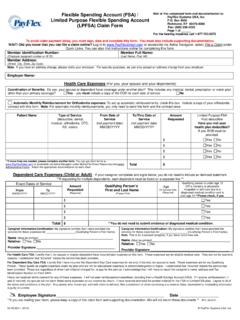Transcription of Using an FSA for Dental Expenses - PayFlex
1 Using your FSA to pay for Dental Expenses ` Eligible Dental Expenses Dental procedures such as teeth cleaning, sealants, fluoride treatments, X-rays, fillings, extractions, dentures and other Dental ailments are all eligible Expenses that can be paid for with your Flexible Spending Account (FSA). When paying for these Expenses , the options listed below are available to you. Remember, the eligible amount is the amount that is designated as your final patient financial responsibility after insurance pays its portion of the bill. Therefore, if your dentist requests or requires either partial or full payment on the date of your service and then indicates on your statement that insurance has been filed, is pending or is estimated, it is best to pay with a form of payment other than your PayFlex Card OR wait until you receive an Explanation of Benefits (EOB) from your insurance provider showing your final patient financial responsibility and then pay for your Dental bill.
2 Payment Options Benefits Things to Option 1: (Preferred method) Once you receive an Explanation of Benefits (EOB) from your insurance provider showing your exact patient responsibility, pay for your Dental service over the phone by providing the number on your PayFlex Card. Expense is automatically deducted from your healthcare Flexible Spending Account Ensures that you only pay for what you owe Helps keep card active Eliminates claim filing You may be required to provide the Explanation of Benefits to PayFlex at a later date to confirm your expense was eligible.
3 Please be sure to keep your EOB. To confirm an expense is eligible, IRS regulations require verification of the date of service, description of service or product and your patient financial responsibility, which is provided on an EOB. Option 2: (Next best method) Once you have received Dental treatment, pay for the bill with cash, check or personal credit card and submit a claim to PayFlex for reimbursement. *Make sure to send a copy of your EOB or itemized statement with your claim. Quick reimbursement Helps keep card active Prevents overpayment status If the itemized statement from your dentist indicates insurance has been filed, is pending or is estimated, you must wait and submit your claim after you receive your EOB from your insurance provider.
4 Option 3: (Only if your dentist requires you to pay before insurance pays) Once you have received Dental treatment, pay for the bill with your PayFlex Card at your dentist office. Expense is automatically deducted from your healthcare Flexible Spending Account Eliminates claim filing If your dentist charges you for an estimated amount OR an amount that is greater than your final patient responsibility (after insurance pays its portion), your FSA will be placed into overpayment status and action will be required. To resolve your overpayment status, submit payment to PayFlex or submit a claim for a previously unreimbursed eligible expense to repay your FSA.
5 By taking action, your PayFlex Card will remain active. Should you or your dentist receive reimbursement from any other coverage such as insurance, ask your Dental provider to credit any amount received back to your PayFlex Card. If that is not possible, you are responsible for reimbursing the plan for the amount you overpaid. Using your FSA to pay for Dental Expenses When Using your PayFlex Card , there are a few things to your PayFlex Card cannot be used to pay for cosmetic Dental procedures such as Dental veneers, bonding and teeth whitening.
6 You should only use your card for the exact amount you are responsible for. For Example: Let s say you visit the dentist to repair a cracked filling. your dentist tells you the expense is $300 and estimates that your out-of-pocket expense will be $72. In this case, since your portion is merely an estimate, you should not use your card to pay at the time of service, but instead wait until you receive the Explanation of Benefits (EOB) from your insurance provider before Using your PayFlex Card to pay for the service. By waiting to receive the exact amount you are responsible for, you will be able to prevent your account from going into overpayment status and avoid having your card de-activated.
7 In this case, if insurance pays 80% of the cost, you would only be responsible for $60 instead of $72. To pay the $60, you can simply call your dentist and provide the office with the number on your PayFlex Card, or you can pay with another form of payment and submit a claim for reimbursement. You may be required to provide an Explanation of Benefits (EOB) from your Dental insurance carrier to confirm that you used your PayFlex Card for an eligible Dental expense. For Example: Let s say you swipe your card to pay for a Dental service and the expense is approved when card is swiped.
8 A month later, you receive a Request for Documentation letter from PayFlex requesting documentation for the transaction. When your card was swiped, ABC FAMILY DENTI was the merchant description provided to PayFlex . Based on this merchant description, it is unclear what service or date of service you paid for with your card. Date Merchant Amount Account 07/08/2011 ABC FAMILY DENTI $ (2011) Healthcare (FSA) In this case, an EOB from your Dental insurance provider is required to confirm that the expense was eligible by verifying the actual date of service, description of service and to confirm whether the amount of your financial responsibility equals or exceeds the amount of the transaction.
9 To submit your EOB to PayFlex , access your alert messages by logging into On My Dashboard, click on Learn More next to the alert message for claims requiring substantiation. Then select the ABC FAMILY DENTI transaction and upload your EOB. If you do not have access to a computer, you may fax or mail your documentation and the Request for Documentation letter to PayFlex . Please note: PayFlex is required by the IRS to ensure participants are utilizing the card for eligible Expenses . This means the date of service, description of service or product and final patient financial responsibility must be verified.
10 Therefore, it is important to keep all itemized statements and EOBs. Using your FSA to pay for Dental Expenses Frequently Asked Questions 1. What does overpayment status mean? Overpayment status occurs when you have used the PayFlex Card to pay for a Dental expense and the documentation does not support the amount paid. For example, if you use your PayFlex Card to pay for a Dental bill that exceeds your final patient responsibility, your account will go into overpayment status OR if you submit an itemized statement from the dentist and it indicates insurance is estimated, pending or filed, the card transaction will be denied until final patient financial responsibility is determined.
